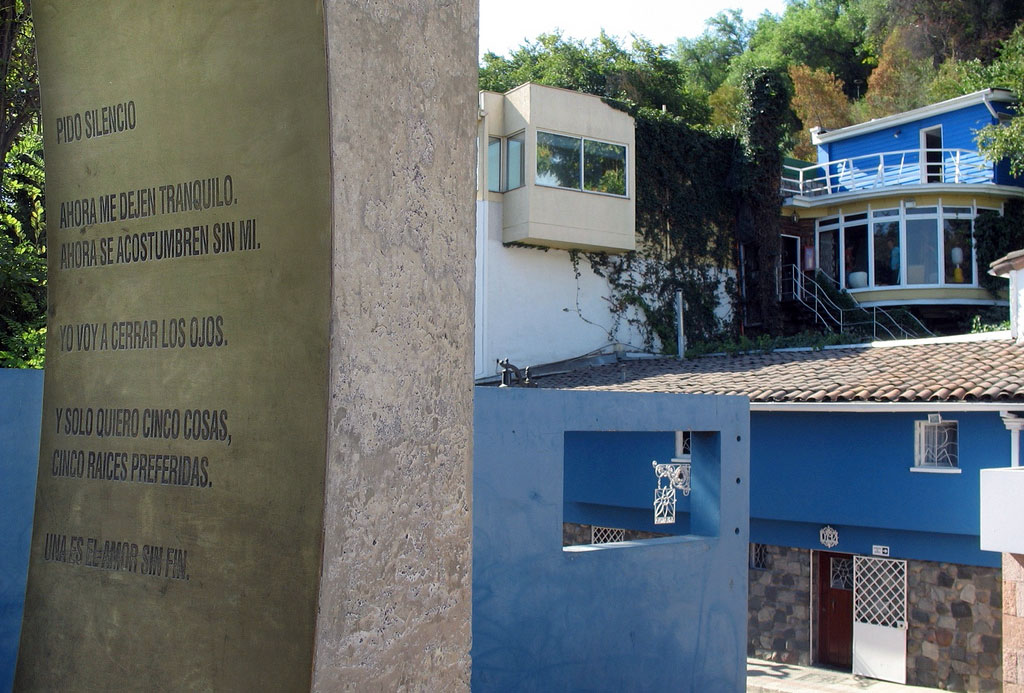At the east end of the Alameda, lively Plaza Italia (formally Plaza Baquedano) marks the boundary of the borough of Providencia, the westernmost of the affluent suburbs that also include Las Condes, Vitacura, and Ñuñoa. While this mostly staid, middle- to upper-middle-class area has shopping malls that seem straight out of the San Fernando Valley, it also has Bohemian enclaves like Barrio Bellavista (Santiago’s main restaurant and nightlife area) and bar-hopper zones like Avenida Suecia. Except in compact Bellavista, points of interest are more spread out than in Santiago Centro, but public transportation is good.
From Plaza Italia, the northbound Pío Nono bridge crosses the Mapocho to Barrio Bellavista. The area’s most conspicuous landmark is the 31-story Torre Telefónica CTC (Av. Providencia 111), the company headquarters in the form of a (now nearly antique) 140-meter cell phone!

Neruda’s poem “Pido Silencio” at his Santiago home, La Chascona. Photo © Andre Oliveira, licensed Creative Commons Attribution.
South of Plaza Italia, Avenida Vicuña Mackenna separates the boroughs of Santiago Centro, on the one hand, and Providencia and Ñuñoa, on the other. On the Providencia side, the Museo Nacional Benjamín Vicuña Mackenna (Av. Vicuña Mackenna 94, tel. 02/2222-9642, 9:30am- 5:30pm Mon.-Fri., 10am-2pm Sat., US$1.20 adults, US$0.60 students and seniors) honors the mayor, historian, journalist, and diplomat responsible for the capital’s 1870s modernization.
On the Mapocho’s north bank between the Padre Letelier and Pedro de Valdivia bridges, the open-air Parque de las Esculturas (Av. Santa María 2201, tel. 02/2340-7303, 10am- 7:30pm daily) showcases abstract works by contemporary Chilean sculptors. It also has an enclosed gallery with rotating exhibitions.
At the foot of massive Cerro San Cristóbal, compact Bellavista is a walker’s delight. In daytime, Santiaguinos cross the Pío Nono bridge to stroll its leafy streets, parks, and plazas and enjoy modest lunch specials at innovative restaurants. At night, they crowd the same places for elaborate dinners before a night at nearby bars, discos, salsa clubs, theaters, and other diversions. Daytime visitors, by the way, may not even realize that this is a nightlife center—most dance clubs, for instance, do not open until 1am or so, and few have prominent signs.
While most visitors see Bellavista as a single neighborhood, the recently rehabbed Avenida Pío Nono is a dividing line between the two comunas (boroughs) that compose the barrio—rough-edged Recoleta to the west and modish Providencia to the east. There’s more style than substance to this, as security-obsessed Providencia makes more conspicuous efforts to prevent auto burglaries and other petty crime in what is, for the most part, a safe area.
On weekends, Pío Nono itself is a frenetic blend of crafts market, cheap sidewalk restaurants, and beer joints. While not as bad as that might sound, it’s less appealing than the perpendicular and parallel side streets.
For a notion of Bellavista’s best, relax on a bench at Plazuela Camilo Mori (Antonia López de Bello and Constitución), a small triangular plaza. Walking north on Constitución, turn into the cul-de-sac at Márquez de la Plata, where poet Pablo Neruda lived at the house he called La Chascona, now a museum. A short walk northwest, Plaza Caupolicán is the main entry point to the 722-hectare Parque Metropolitano, a hillside and hilltop public park. A funicular railway carries visitors past the city zoo to the summit, whose terrace offers exceptional views on clear days. From here, a teleférico (cable gondola) connects the park to eastern Providencia.
On the Recoleta side, at the north end of Avenida La Paz, famous figures from Chile’s past are among the two million reposing in the Cementerio General (General Cemetery, 1897).
Inconspicuous from the street side of its cul-de-sac, Pablo Neruda’s hillside home La Chascona today houses the Museo Neruda (Márquez de La Plata 0192, tel. 02/2737-8712, 10am-6pm Tues.-Sun. Mar.-Dec., 10am-7pm Tues.-Sun Jan.- Feb., US$8 adults, US$3 students and seniors). It may be the most conventional of his three houses (the others, also open for visits, are in Valparaíso and the beach community of Isla Negra).
Opposite the house, a small amphitheater tucked into the slope is an ideal complement to the residence, which has been restored since its military sacking in 1973 (Neruda, a committed Salvador Allende supporter, died about a month after the coup). Audioguided tours are available in English, French, German, and Portuguese. The Fundación Neruda also offers hour-long guided tours by reservation. The museum also operates a café, bookstore, and souvenir shop.
All but two of Chile’s presidents are interred among the Gothic, Greek, Moorish, and Egyptian-style sepulchers of the Cementerio General (Av. La Paz s/n, tel. 02/2637-7800, 8:30am-5:30pm Mon.-Fri., 8am- 5:30pm Sat.-Sun. and holidays). Bernardo O’Higgins’s remains at rest in the Alameda’s Altar de la Patria, Gabriel González Videla lies in his native La Serena, and General Augusto Pinochet—if he qualifies—was cremated.
Other notable figures include diplomat Orlando Letelier (killed by a car bomb in Washington, D.C., under orders from a Pinochet subordinate); Venezuelan-born educator Andrés Bello; and cultural icon, folksinger, and songwriter Violeta Parra. Nobel Prize poets Gabriela Mistral and Pablo Neruda originally rested here as well, but Mistral’s body was moved to her Elqui valley birthplace and Neruda’s to his Isla Negra beach residence. Salvador Allende moved in the other direction—after 17 years in Viña del Mar, he regained his freedom to travel after the Pinochet dictatorship’s demise and has a monumental memorial here. Another indicator of change is sculptor Francisco Gazitúa’s Rostros (Faces), memorializing the regime’s victims.
Excerpted from the Fourth Edition of Moon Patagonia.